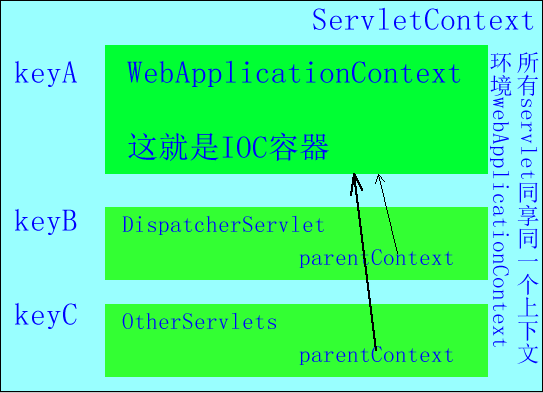一、先说ServletContext
javaee标准规定了,servlet容器需要在应用项目启动时,给应用项目初始化一个ServletContext作为公共环境容器存放公共信息。ServletContext中的信息都是由容器提供的。
举例:
通过自定义contextListener获取web.xml中配置的参数
1.容器启动时,找到配置文件中的context-param作为键值对放到ServletContext中
2.然后找到listener,容器调用它的contextInitialized(ServletContextEvent event)方法,执行其中的操作
例如:在web.xml中配置
<context-param>
<param-name>key</param-name>
<param-value>value123</param-value>
</context-param>
<listener>
<listener-class>com.brolanda.contextlistener.listener.ContextListenerTest</listener-class>
</listener>
配置好之后,在该类中获取对应的参数信息
package com.brolanda.contextlistener.listener;
import javax.servlet.ServletContext;
import javax.servlet.ServletContextEvent;
import javax.servlet.ServletContextListener;
public class ContextListenerTest implements ServletContextListener {
public void contextDestroyed(ServletContextEvent event) {
System.out.println("*************destroy ContextListener*************");
}
@SuppressWarnings("unused")
public void contextInitialized(ServletContextEvent event) {
System.out.println("*************init ContextListener*************");
ServletContext servletContext = event.getServletContext();
System.out.println("key:"+servletContext.getInitParameter("key"));
}
}
执行流程:
web.xml在<context-param></context-param>标签中声明应用范围内的初始化参数
1.启动一个WEB项目的时候,容器(如:Tomcat)会去读它的配置文件web.xml.读两个节点: <listener></listener> 和 <context-param></context-param>
2.紧接着,容器创建一个ServletContext(上下文)。在该应用内全局共享。
3.容器将<context-param></context-param>转化为键值对,并交给ServletContext.
4.容器创建<listener></listener>中的类实例,即创建监听.该监听器必须实现自ServletContextListener接口
5.在监听中会有contextInitialized(ServletContextEvent event)初始化方法
在这个方法中获得ServletContext = ServletContextEvent.getServletContext();
“context-param的值” = ServletContext.getInitParameter("context-param的键");
6.得到这个context-param的值之后,你就可以做一些操作了.注意,这个时候你的WEB项目还没有完全启动完成.这个动作会比所有的Servlet都要早.换句话说,这个时候,你对<context-param>中的键值做的操作,将在你的WEB项目完全启动之前被执行.
web.xml中可以定义两种参数:
一个是全局参数(ServletContext),通过<context-param></context-param>
一个是servlet参数,通过在servlet中声明 <init-param>
<param-name>param1</param-name>
<param-value>avalible in servlet init()</param-value>
</init-param>
第一种参数在servlet里面可以通过getServletContext().getInitParameter("context/param")得到
第二种参数只能在servlet的init()方法中通过this.getInitParameter("param1")取得
二、spring上下文容器配置
spring为我们提供了实现ServletContextListener接口的上下文初始化监听器:org.springframework.web.context.ContextLoaderListener
spring为我们提供的IOC容器,需要我们指定容器的配置文件,然后由该监听器初始化并创建该容器。要求你指定配置文件的地址及文件名称,一定要使用:contextConfigLocation作为参数名称。
<context-param>
<param-name>contextConfigLocation</param-name>
<param-value>/WEB-INF/applicationContext.xml,/WEB-INF/action-servlet.xml,/WEB-INF/jason-servlet.xml</param-value>
</context-param>
<listener>
<listener-class>org.springframework.web.context.ContextLoaderListener</listener-class>
</listener>
该监听器,默认读取/WEB-INF/下的applicationContext.xml文件。但是通过context-param指定配置文件路径后,便会去你指定的路径下读取对应的配置文件,并进行初始化。
三、spring上下文容器配置后,初始化了什么?
既然,ServletContext是由Servlet容器初始化的,那spring的ContextLoaderListener又做了什么初始化呢?
1、servlet容器启动,为应用创建一个“全局上下文环境”:ServletContext
2、容器调用web.xml中配置的contextLoaderListener,初始化WebApplicationContext上下文环境(即IOC容器),加载context-param指定的配置文件信息到IOC容器中。WebApplicationContext在ServletContext中以键值对的形式保存
3、容器初始化web.xml中配置的servlet,为其初始化自己的上下文信息servletContext,并加载其设置的配置信息到该上下文中。将WebApplicationContext设置为它的父容器。
4、此后的所有servlet的初始化都按照3步中方式创建,初始化自己的上下文环境,将WebApplicationContext设置为自己的父上下文环境。
对于作用范围而言,在DispatcherServlet中可以引用由ContextLoaderListener所创建的ApplicationContext中的内容,而反过来不行。
当Spring在执行ApplicationContext的getBean时,如果在自己context中找不到对应的bean,则会在父ApplicationContext中去找。这也解释了为什么我们可以在DispatcherServlet中获取到由ContextLoaderListener对应的ApplicationContext中的bean。
四、spring配置时:<context:exclude-filter>的使用原因,为什么在applicationContext.xml中排除controller,而在spring-mvc.xml中incloud这个controller
既然知道了spring的启动流程,那么web容器初始化webApplicationContext时作为公共的上下文环境,只需要将service、dao等的配置信息在这里加载,而servlet自己的上下文环境信息不需要加载。故,在applicationContext.xml中将@Controller注释的组件排除在外,而在dispatcherServlet加载的配置文件中将@Controller注释的组件加载进来,方便dispatcherServlet进行控制和查找。故,配置如下:
applicationContext.mxl中:
<context:component-scan base-package="com.linkage.edumanage">
<context:exclude-filter expression="org.springframework.stereotype.Controller" type="annotation" />
</context:component-scan>
spring-mvc.xml中:
<context:component-scan base-package="com.brolanda.cloud" use-default-filters="false">
<context:include-filter expression="org.springframework.stereotype.Controller" type="annotation" />
</context:component-scan>
